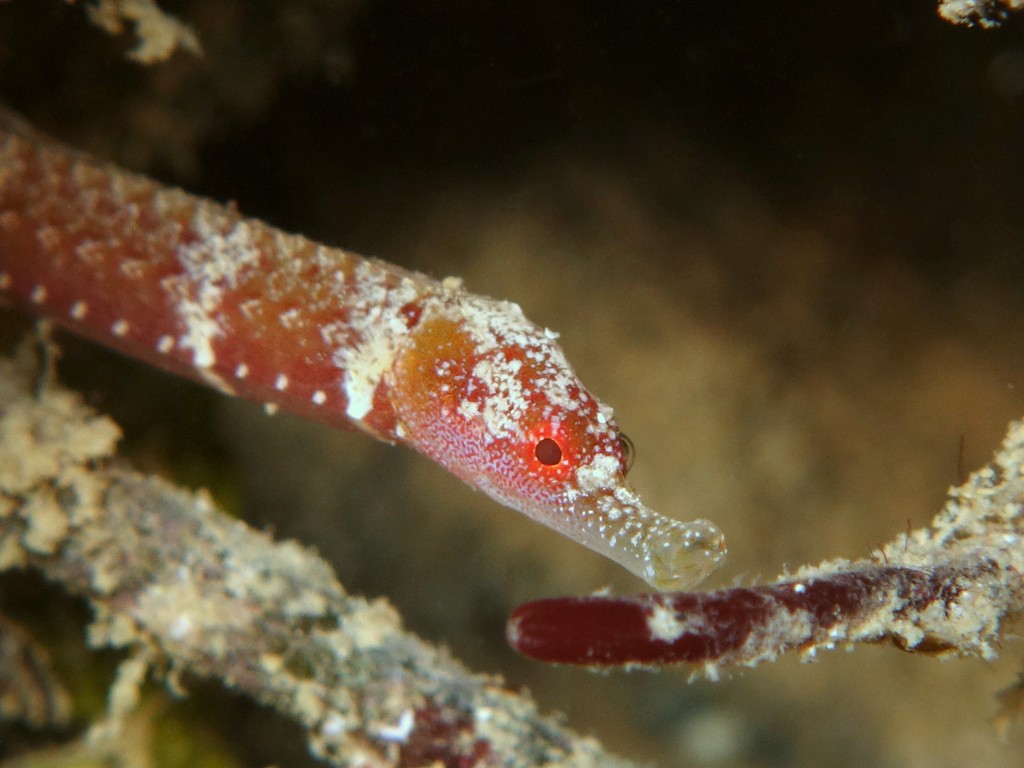FESTUCALEX KULBICKII - (FRICKE, 2004)
Picture courtesy of: Alain Daoulas
Poisson-pipe de Kulbicki, Kulbicki’s pipefish,
Description
Dorsal soft rays (total): 19-22; Anal soft rays: 4; Pectoral fin rays: 11-14; Caudal fin rays: 10; Trunk rings: 16 (16-17); Tail rings: 33 (31-40); Total rings: 49 (48-57); Subdorsal rings: 2 + 5 (1-2 + 5-6); Total subdorsal rings: 7. Head: 7.4 (6.6-8.7) in SL (11-15% of SL). Median dorsal snout ridge entire, not strongly elevated, without bony knobs or spines, not confluent with orbital ridges. A short indistinct opercular ridge; operculum with striae. Other head ridges low and indistinct. Snout length: 2.5 (2.3-2.6) in head length (5-6 % of SL). Snout depth: 6.5 (4.2-9.5) in head length (2-3 % of SL). Eye diameter: 6.0 (3.8-6.7) in head length (2-3 % of SL). Superior and inferior trunk ridges continuous with their respective tail ridges. Lateral trunk ridge not deflected near anal fin, ends mid-laterally on 5th (5th-9th) tail ring. Margins of head and body ridges entire, neither denticulate nor serrate. Dermal flaps absent. Body depth: 21 (19-27) in SL (4-5 % of SL). Body width: 22 (23-31) in SL (3-5 % of SL). Preanus length: 2.3 (2.2-2.6) in SL (39-47% of SL). Principal tail ridges behind dorsal fin with a small posterior spine-like projection on each ring. Brood pouch under tail rings 1-12, pouch folds present, semi pouch closure. Dorsal fin origin on trunk; dorsal fin base not elevated. Dorsal fin base length: 10.2 (7.5-8.3) in SL (10-13% of SL). Predorsal length: 2.4 (2.4-2.6) in SL (38-42% of SL). Pectoral fin length 45 (30-46) in SL (2-4 % of SL). Prepectoral length: 6.9 (6.2-7.6) in SL (13-16% of SL). Caudal fin length: 35 (29-40) in SL (2-3 % of SL). Max. length: 7.0 cm SL. Depth range: 2 - 56 m.
Color
In alcohol: head and body pale in fresh specimens, sides of head with dark blotches behind eye and on operculum. Eye dark grey. Basal half of each ring with a vertical dark streak. Back with dark saddles. Fins pale.
In life: head with pink blotches behind the eyes and on the operculum. Body with 13 broad pink bands, 4–5 on trunk and 8–9 on tail. A white morph exist.
Etymology
Festucalex: from Latin, festuca = straw + from Latin suffix, -ex = cut down.
kulbickii: this new species is named in honour of Dr. Michel KULBICKI (I.R.D., Nouméa, New Caledonia), who collected the holotype and other syngnathids.
Original description: Festucalex kulbickii Fricke, 2004 - Type locality: Grande Rade - Nouméa - New Caledonia, 22°14 04 N / 166°24 01 E, depth: 2 m, coral and sand; M. KULBICKI; 2 Apr. 1999.
Distribution
Western Pacific: West Papua (Indonesia), Papua New Guinea and New Caledonia.
Biology
Ovoviviparous. Male carries the eggs in a brood pouch. Found in coastal reefs.
Similar species
Cosmocampus banneri (Herald & Randall, 1972) - Reported from New Caledonia.
Phoxocampus belcheri (Kaup, 1856) - Reported from New Caledonia.
Phoxocampus diacanthus (Schultz, 1943) - Reported from New Caledonia. Dorsal soft rays (total): 20-24. Rings: 15-16 + 25-28. Reaches at least 9.0 cm. Likely to feed on small crustaceans.
